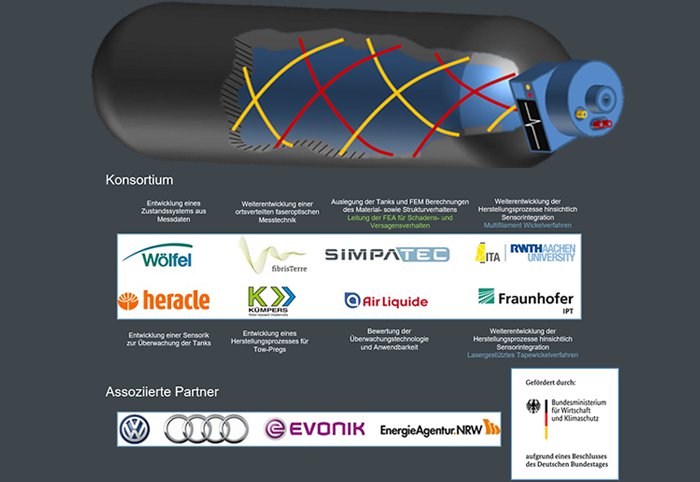
Publicly funded R&D project smartVessel
ESPECIALLY FOR OUR USERSIn the publicly funded research project smartVessel, the focus is set on the integration of fiber-based sensors during the production of hydrogen tanks for intelligent condition monitoring, lifetime prediction and evaluation.
Applying hydrogen as an energy carrier is currently seen as a partial solution to address climate change. Hydrogen fuel represents an alternative fuel for automotive applications. Hydrogen storage is a key technology for the implementation of hydrogen and fuel cell technology and is used in both stationary and mobile areas of energy supply in transportation. Increasing demand for low emission fuels and implementation of current emission standards are the major factors driving the growth in the market.
Conventional methods of non-destructive testing such as ultrasonic testing or visual inspection help to increase reliability and safety. However, this involves additional operating costs and time-consuming tests for the use of hydrogen tanks. On the other hand, the aspect of safety plays a decisive role since not every defect - such as fiber breakage inside - can be detected by the inspection methods. Furthermore, the critical structural influence of possible defects during an inspection cannot be estimated directly. By integrating the tank into the structure of a vehicle they would no longer be accessible, creating uncertainties in terms of operational safety.
To be able to ensure an increase in safety the use of intelligent structural and local sensor condition monitoring is required as well as the prediction of the remaining lifetime of the tank. The solution is condition-based maintenance grounded on Structural Health Monitoring (SHM). The SHM system takes the role of a key technology for live monitoring of the tank/vessel.
The objective of the project is the modification and application of two manufacturing processes using high-performance materials (FVK) for the integration of a glass fiber-based sensor fiber. On the one hand, the novel multifilament winding process (MFW) is used by the laser-assisted thermoplastic tape winding process developed at Fraunhofer and, on the other hand, a transfer of the sensor integration to the industrially established wet winding process by the ITA of RWTH Aachen University.
Further goals compared to the real-time condition monitoring of the tank includes reducing maintenance costs of at least 50% as well as operating the entire lifetime of these safety-relevant components for at least 20 years. With the help of state-of-the-art CAE tools and methods deeper insights into the material and structural behavior are possible during the development phase. This allows optimization measures in the area of topology, laminate structure, positioning of the sensor fiber, ... to be realized in the development process.
